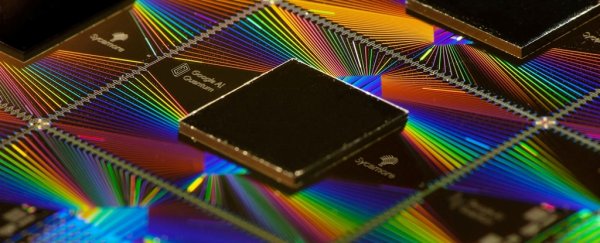Are you in the market for a loophole in the laws that forbid perpetual motion? Knowing you've got yourself an authentic time crystal takes more than a keen eye for high-quality gems.
In a new study, an international team of researchers used Google's Sycamore quantum computing hardware to double-check their theoretical vision of a time crystal, confirming it ticks all of the right boxes for an emerging form of technology we're still getting our head around.
Similar to conventional crystals made of endlessly repeating units of atoms, a time crystal is an infinitely repeating change in a system, one that remarkably doesn't require energy to enter or leave.
Though such a thing comes close to breaking certain laws of thermodynamics, the fact that the system's entropy doesn't increase means it should sit on the right side of physics.
In reality, such a crystal might look like an oscillation of some sort that doesn't synchronize with the rest of the system's rhythms. A laser tapping out a steady beat on your time crystal, for example, might make its particles' spins flip only on every other tap.
This recalcitrant flip-flopping is a signature time crystal behavior, and has been used as evidence for the design and production of time crystals in past experiments.
But the sheer complexity of a huge number of interacting quantum objects all swinging to their own rhythm leaves some wiggle room for explanations that aren't necessarily dependent on the same rules that underpin time crystal physics.
So while unlikely, we can't rule out that a system that initially looks like a time crystal might in reality warm up over the eons and eventually fall into disarray.
You could just sit and watch your crystal hum away until the eventual heat death of the Universe, of course. Or you could let a quantum computer carry out the job for you.
"The big picture is that we are taking the devices that are meant to be the quantum computers of the future and thinking of them as complex quantum systems in their own right," says Stanford University physicist Matteo Ippoliti.
"Instead of computation, we're putting the computer to work as a new experimental platform to realize and detect new phases of matter."
The starting place for this particular time crystal was a surprisingly unintentional one, emerging from work conducted by Stanford theoretical physicist Vedika Khemani on non-equilibrium physics.
We're intimately familiar with the consequences of this kind of physics in everyday life. Leave your hot cup of coffee out on the bench for half an hour, and you'll discover how quickly its heat energy dissipates as it sits out of equilibrium with its environment.
Khemani and her colleagues were more interested in the imbalance of energy on the far less intuitive level of quantum physics.
It was only when a reviewer of Khemani's research drew her attention to similarities between her own work and time crystals that she turned her focus to this exciting new field of physics.
"Time-crystals are a striking example of a new type of non-equilibrium quantum phase of matter," says Khemani.
"While much of our understanding of condensed matter physics is based on equilibrium systems, these new quantum devices are providing us a fascinating window into new non-equilibrium regimes in many-body physics."
Modelling their time crystal on Google's quantum technology allowed the team to look for signs of infinite repetition within just a few hundred kicks of a laser pulse. They could also run the simulation backwards and scale its size.
"It essentially told us how to correct for its own errors, so that the fingerprint of ideal time-crystalline behavior could be ascertained from finite time observations," says Roderich Moessner, a theoretical physicist from the Max Planck Institute for Physics of Complex Systems in Germany.
Having ways to model actual time crystals with confidence that they represent a truly unique phase of matter could be invaluable for probing the insane complexities of non-equilibrium quantum physics.
Time crystals promise to be a window into the novel ways that a wide range of complex systems operate, providing insights not just into quantum spaces, but systems as complex as our own brains.
One day a lot of scientists across a range of fields will be in the market for a time crystal. Now there's less of a chance they'll be ripped off.
This research was published in Nature.
